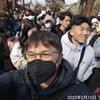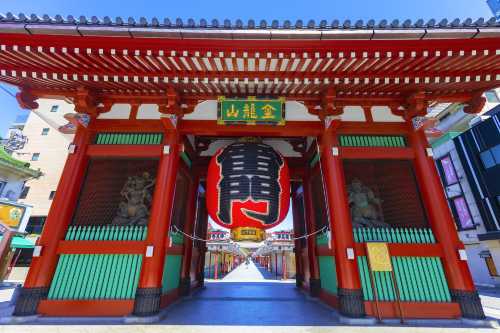Tokyo’s Asakusa: Tradition, Tastes & Treasure Hunts 🎏✨ Kick off your Tokyo adventure with the vibrant pulse of Asakusa! From savoring vegan ramen that’s nothing short of life-changing, to scoring unique souvenirs along lantern-lined lanes, this neighborhood is all about capturing the spirit of old-meets-new Japan. Don’t skip skincare shopping—Japanese brands here are top-tier, and Onitsuka Tiger sneakers make the coolest souvenir. 🗺️ Ultimate Asakusa Stroll: Start early at Sensō-ji (2 Chome-3-1 Asakusa)—Japan’s oldest temple—where the bright red Thunder Gate and incense cloud offer iconic, insta-worthy angles. Wander Nakamise Shopping Street (1 Chome-36-3 Asakusa) for street snacks and quirky gifts (try melon pan and vegan sweet potato treats!). Snap overhead shots of crowds and shopfronts for that bustling Tokyo vibe. Next, head to Asakusa Culture Tourist Information Center (2 Chome-18-9 Kaminarimon). Climb to the top floor for a panoramic terrace shot—the temple, Skytree, and market bustle all in one frame. Grab maps or ask about nearby vegan eats (I never imagined ramen this good!). 🌟 Insider Tips: Skin care is a must! Stock up on sheet masks and lotions at local drugstores. Arrive before 9 AM for peaceful temple vibes and crowd-free photos. Shops mostly open by 9 but get busy after lunch. Try on retro-cool Onitsuka Tiger sneakers for the ultimate Tokyo memento! ❗ Precautions: Sensō-ji closes at 5 PM sharp. Many stalls are cash only. Watch for pickpockets in the crowd and hydrate—Tokyo summers are humid! #Tokyo #Asakusa #CultureTrip #VeganJapan #TravelTips#thesolotable
The solo table
Popular Trip Moments
Asakusa: Must-Visit Destination with SkyTree Views and Vibrant Streets | Shrine Next to B Asakusa: A Hidden Gem of Tradition and Tranquility | 🏛️ From Bank to Boutique: Chilling at BANK in Nihonbashi Kabutocho | 🌴 Beach Vibes in the City at BONDI COFFEE SANDWICHES | Centurion Hotel Ueno, Ueno, Tokyo | 🍁 Autumn Stroll Around Nippon Budokan & Kitanomaru Park | Tokyo Tower and breathtaking views create an exquisite dining experience. | Enjoy the freshness and elegance of Edomae cuisine at Tsukiji Outer Market | SAKURA JINGU. | Hotel Chinzan-so Tokyo Garden | 🍁 Autumn Colors & Puppy Joy at Yoyogi Park | Experience the Hokuriku Shinkansen | Stay With Meee 🎶🎤 Tokyo Vibes | Tokyo Kaikan and Nearby Attractions | Pork Ramen Butayama Ueno | Asakusa - Flamingo Soufflé | 🖤 A Chic Pause at MUSEUM CAFE, Artizon Museum | 🍃 Art, Garden Views & French-Inspired Flavors at Café Dining SA FU | [Tokyo/Akasaka🇯🇵] Hie Shrine, the Imperial Palace's inner city power spot | 🌿 Sunlit Lunch at Cafe TEIEN, Tokyo Metropolitan Teien Art Museum | 🌎 A Global Vibe at TENCUPS Café, Shibuya | 【Tokyo/Shimokitazawa】Thick-Cut Tongue and Harami to Savor! | 🍑 Refresh & Recharge at SAKUU 茶空 in JINNAN HOUSE | ☕ Style & Flavor at BLUE SIX COFFEE in Meiji Park | ☕️ Relaxing Afternoon at Meiji Park Market | Recommended Izakaya in Tokyo for Delicious Fish | Roppongi Hills Christmas Market | Tokyo: A Gourmet Journey to Find a Bite of Happiness | Tokyo, the city where time and light intersect | 🌇 Stylish & Spacious: Brooklyn Roasting Company at Tokyo International Forum
Trending Travelogues
Recommended Attractions at Popular Destinations
Popular Attractions in Sydney | Popular Attractions in Dubai | Popular Attractions in Paris | Popular Attractions in Shanghai | Popular Attractions in Phuket | Popular Attractions in New York | Popular Attractions in Tokyo | Popular Attractions in Bali | Popular Attractions in Melbourne | Popular Attractions in West Lake | Popular Attractions in Iguazu National Park(Argentina) | Popular Attractions in London | Popular Attractions in Rome | Popular Attractions in Kuala Lumpur | Popular Attractions in Chefchaouene | Popular Attractions in Singapore | Popular Attractions in Kyoto | Popular Attractions in Los Angeles | Popular Attractions in Zanzibar Island | Popular Attractions in Las Vegas | Popular Attractions in Osaka | Popular Attractions in Walt Disney World Resort | Popular Attractions in Beijing | Popular Attractions in Bangkok | Popular Attractions in Barcelona | Popular Attractions in Chengdu | Popular Attractions in Florence | Popular Attractions in Madrid | Popular Attractions in Jungfrau Region | Popular Attractions in Istanbul
Popular Restaurants in Tokyo
Sushi no Midori | Izuei Main Restaurant | Tsukiji Sushi Sei Honten | Ichiran Ramen | Mikawa Zezankyo | Ichiran(Shinbashi) | Sky Lounge Top Of Tree | Makimura | Nihonbashi Ten-don Kaneko Hannosuke Hon Ten | Azabu Kadowaki | Nodaiwa Azabu Iikura Honten | bills Odaiba | L'Effervescence | Rokurinsha | SÉZANNE | Saito | Sushi no Midori | Jojoen | Luke’s Lobster Harajuku Cat's Street | Tsukiji Aozora Sandaime | Ningyouchouimahan | Gyu-nabe Yonekyu | Blue Bottle Coffee(Kiyosumi Shirakawa Roastery & Cafe) | Quintessence | Shiseido SALON de Café | Kunimi | Hanamaru Udon | SEIZAN | Torishiki | Inshoutei
Popular Ranked Lists
Top 50 Luxury Hotels near Alba | Top 20 Luxury Hotels near Osceola County | Popular Premium Hotels in Detroit | Top 10 Trending Attractions in Tokyo | Top 20 Must-Visit Restaurants in Shangri-La | Popular Trending Attractions in Deqing | Top 20 Must-Visit Restaurants in Incheon | Top 50 Must-Visit Restaurants in Guiyang | Popular Trending Attractions in Tekes | Top 50 Luxury Hotels near Chichester | Top 20 Must-Visit Restaurants in Amsterdam | Top 20 Must-Visit Restaurants in Weihai | Top 10 Premium Hotels near Penzance | Top 50 Luxury Hotels near Hartford | Top 20 Must-Visit Restaurants in Yichang | Top 10 Luxury Hotels near Arapahoe County | Popular Luxury Hotels in Bouches-du-Rhone | Top 20 Must-Visit Restaurants in Boracay Island | Top 10 Trending Attractions in Wuxi | Top 50 Luxury Hotels near Morris County | Popular Luxury Hotels in Versailles | Top 20 Must-Visit Restaurants in Harbin | Top 20 Must-Visit Restaurants in Prague | Popular Premium Hotels in Leukerbad | Popular Luxury Hotels in Yvelines | Popular Premium Hotels Near Saint John | Popular Trending Attractions in Yantai | Top 10 Trending Attractions in Nanning | Top 20 Must-Visit Restaurants in Venice | Top 20 Must-Visit Restaurants in Changchun
About
Payment methods
Our partners
Copyright © 2025 Trip.com Travel Singapore Pte. Ltd. All rights reserved
Site Operator: Trip.com Travel Singapore Pte. Ltd.
Site Operator: Trip.com Travel Singapore Pte. Ltd.













